Curious about how to write and design chatbots? This preview is made up of material from the first few lessons of our Conversation Design for Chatbots course.
If you’re a UX writer, content strategist, developer, project manager, product manager, producer, or anyone interested in learning how to create a chatbot, this course is for you.
Learning how to write and design chatbots is an essential skill
This first unit will cover all of the basics of what a chatbot is, and explain why learning how to write and design chatbots is so crucial.
Before we dive deep into UX writing for chatbots, it’s important to understand the vocabulary used in this course and in the chatbot and conversation design industry.
A few definitions
First, and most importantly, what is a chatbot?
1. A bot (short for software robot) is an automated, conversation-based experience that lives within messaging apps, websites, or on devices. It simulates human conversation via voice or text, which is why bots are often known as voicebots or chatbots. Bot decisions are sometimes powered by conversational artificial intelligence (AI), by human-created rules, or a hybrid of both methods.
The alarm clock on Alexa is a bot. Automated customer service experiences like American Express, TD Ameritrade, and The Weather Channel on Facebook are chatbots. The SMS alerts you receive from a drugstore like CVS (a pharmacy similar to Boots in the UK) are from a chatbot. Bots can be purely entertaining, teach you things, grow your business, help build a habit, send news updates, answer frequently asked questions, and lots more.
2. Conversation design is the art of writing and designing for chatbots and/or voicebots. This is a newer design discipline based on the idea that we can teach computers how to have human-like conversations.
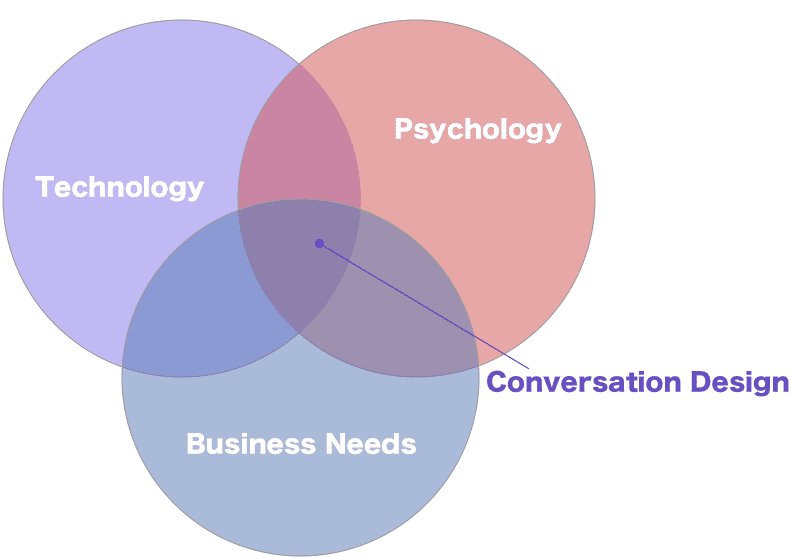
The automated dialog and architecture of the chatbot experience typically unfolds in either a rule-based or an intent-based way on a variety of device and software interfaces. In some cases, the chatbot may use conversational AI and natural language processing (NLP) to allow for a more sophisticated and open-ended conversation with a user. (We’ll define these terms in just a moment.)
To put it more simply, conversation design helps a chatbot talk to a user, and helps the user understand what to do, so they achieve what they set out to do when they begin their conversation. Just like in content design, users have a goal and conversation design helps them reach it. While chatbots rely on technology, conversation design is very human-focused. As Erika Hall puts it in her book, Conversational Design:
“Conversational design is truly human-centered design, every step of the way. There is no next big thing, only the next step in an unfolding story of how people use technology to be more themselves.”

3. Conversation designers are content designers for chatbots. They design and write the dialog for the chatbot, as well as any other text, buttons, intents and replies needed to support the user experience within an automated conversation.
4. A conversational interface is the application or platform that a chatbot lives on, like Facebook Messenger, Slack, Twitter DM, a website, an app, or a device like Amazon Echo or Google Home.
In the same way that content designers write user interface (UI) text, conversation designers write the conversational user interface (CUI) text that a user sees or hears (also called VUI for purely voice-based experiences, pronounced “voo-ey”). In addition to writing, conversation designers also determine:
- Which paths the user has an option to go down
- What happens if they try to veer off those paths
- Everything else that goes into the user experience
Conversation designers today act as writers and designers in one.
5. One more term we’ll want to cover is intent. A user interacts with a business or a software program because they have a need or a want. That need or want is called an intent in conversation design. Behind the scenes, the bot is constantly listening for an intent to be invoked by a user, which can be done through many different utterances (the words users actually say). When an utterance match to an intent is found, that intent step (an action, words, or both) is triggered and the user is directed to the corresponding conversation path.
The user might state their intent in several different ways—each of which we’ll need to recognize and respond to. For example, if a user wants to set an alarm, they might begin with:
- “I need to set an alarm.”
- “Wake me up at eight.”
- “Set an alarm for eight A.M.”
- “Change my alarm for tomorrow.”
The bot would need to understand the intent behind each of these utterances, and ask for clarifying specifics, like what day or what time to set the alarm for.
6. Our last term is entity or slot. You can think of a “slot” as something like a variable or a parameter in programming. For example, in UX writing we might show text like:
Hello {first name}!
The placeholder entity or slot in this example is ‘first name.’
Two main types of bots
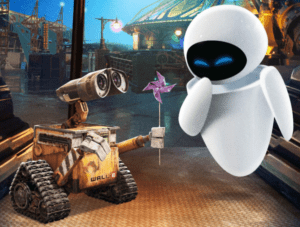
Currently, there are 2 main ways that chatbots work. Both require conversation design.
Rule-based chatbots are bots that are based on a set of rules and use a planned, guided dialog. These bots have a script that the user must stay on. If they try to go off script, they will likely encounter an error.
Conversational AI-based chatbots are bots that use technologies like natural language processing (NLP), natural language understanding (NLU) and artificial intelligence (AI) models to parse different intents and decide which answers to serve up. This often makes for a more natural, free flowing and open conversation.
The best way to understand the difference between rule-based and conversational AI-based chatbots is that with rule-based chatbots, the bot only says what the conversation designer tells it to say and nothing more. It’s completely pre-determined. The bot follows a strict script. If your user goes off-script, the bot is lost.
Rule-based bots are much simpler than NLP-based bots. They’re cheaper, easier, and faster for companies to build. They don’t require artificial intelligence. They do require human intelligence—that’s where you come in!
A conversational AI bot learns over time, starting with what we train it to know, but it still needs the conversation designer’s help to deliver its knowledge. It’s like a chatbot that went to school. It still needs to do homework practice and learn how to apply its new skills in the real world, but it’s able to learn over time.
With a conversational AI-based bot, the user can use their own words or phrases and the bot will look for similarities from past conversations (training) or existing data models to interpret the question and provide an answer. They may also know more information that exists outside of their script—like the weather, the day and time, or information about the user—and be able to reference that in the conversation, whether or not a user asks for it.
A conversational AI bot is a more sophisticated, or “smarter” form of chatbot. It also requires deeper development resources and comes with a heavier price tag. Large corporations most commonly build these bots. There are tools available to help conversation designers implement these technologies into their own projects, like Voiceflow, which we will be using later.
In this course, we’ll be creating a mostly rule-based chatbot, but we will introduce you to ways to add trained NLP intents into your chatbot, so that you can understand their purpose. Your bot will be simple and straightforward so you understand the basic principles and requirements for bots.
Although many of the design principles apply to both text and voice chatbots, we’ll focus on simple CUI design in this course. Everything you learn here will help you to build more sophisticated bots down the road.
Why businesses want to write and design chatbots
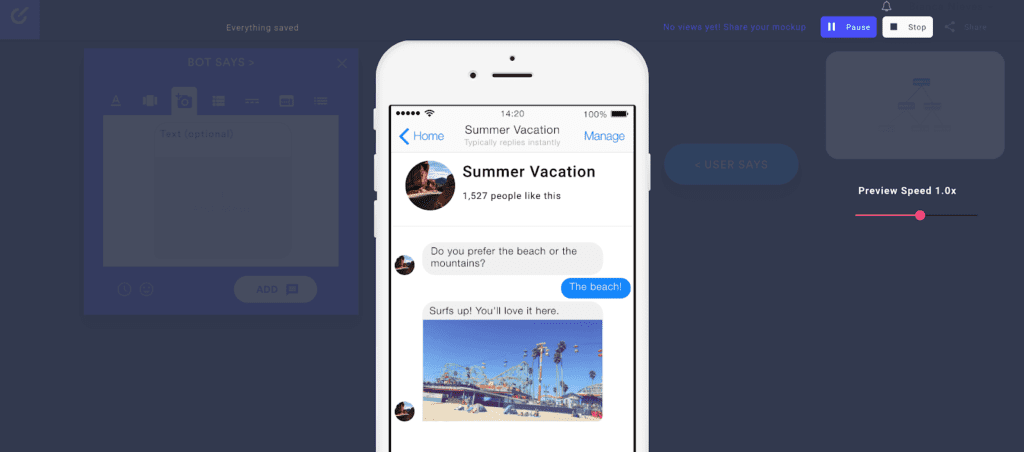
It seems like every website or store you visit has some form of chat component, either automated or human-powered. There are clear reasons a business may want to implement a chatbot, and many benefits to sales, marketing and support with automation.
Convenience
The first thing that comes to mind is the convenience for the business and the customer. Chatbots enable businesses to respond to customers 24/7, even when the business is closed. A business can also have personalized conversations with many customers at once, plus scale their marketing, sales, and support initiatives to reduce queues and wait times.
During the COVID-19 pandemic, there was a big increase in adoption of chatbots for many businesses, like airlines and pharmacies, who needed to quickly disperse information and respond to customer questions and inquiries, but did not have the manpower to do so in a reasonable timeframe. Chatbots helped these businesses to help and respond to users with repetitive questions, and escalate the more complex issues to their human customer services representatives.
No longer having to wait for a human to join a live chat, or wait on hold on the phone is a huge benefit of chatbots. According to Salesforce, 59% of customers prefer self-service when they have a simple question or issue. A customer can also choose to chat at the time that works best for them because of the always-on nature of a chatbot. If they want to send a message at 3 a.m. they can, and if they want to pick up the conversation at a later time or even another day, they have the ability to do so.
Efficiency
Chatbots are a form of automation, meaning their messages are triggered automatically through a customer action instead of a business owner sending a message from their own phone or computer. Delivering a personalized, consistent brand experience to every single customer that engages with a chatbot is invaluable to a business.
Persistent channels
If you currently receive automated text messages from a business (like a political campaign or a store you shop at), you may notice that you receive them on a scheduled weekly or monthly basis. These bots offer businesses a persistent, continuous channel for communicating with customers.
When a user texts a business or messages the business’s Facebook chatbot, they become a user that the business can re-engage with strategically at a later time, including using personalized information like their name or referring to previous questions. As we mentioned earlier, when a lead leaves a website, they’re usually gone.
If a potential customer who visits a website hasn’t signed up for a newsletter or left an email address, the business will have a hard time initiating any engagement with them again. Bots create a 2-way connection that can help build ongoing relationships.
Technology
Emerging technologies, like chatbots, help to set a business apart from their competitors by showing innovation and a willingness to try even harder to meet customer needs.
Additionally, having many automated conversations with users allows the business to take a look inside the minds of their customers. They can see the most frequent requests, look at instances where a user is trying to use the chatbot for something it was not built for, or quickly survey a large group of people.
Chatbot data is very useful for the business. If a business is using conversational AI for their chatbot, they are able to improve their NLU data model and train their chatbot to be smarter using the conversation data from real customers.
How does a conversation designer write and design chatbots?
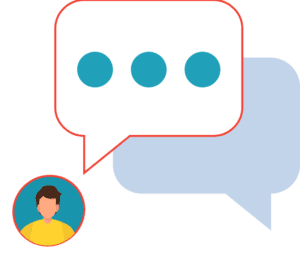
As we covered in the previous lesson, a conversation designer is a UX writer for chatbots. There are many other common names in the industry for a conversation designer:
- Chatbot Writer
- Dialog Designer
- AI Interaction Designer
- Conversation Architect
- Conversational UX Writer
- Conversational Designer
- Conversational UX Designer
- Conversational Experience Designer (CxD)
They all do the same thing—design the conversation that a user has with a computer.
UX Writers make excellent conversation designers
There’s a lot of UX within conversation design, which is why UX writers make great conversation designers.
With chatbots, the words that appear in on-screen speech bubbles make up almost the entire experience. The dialog between the bot and the user determines the different paths they can take, so the words become the primary mode of interaction.
How the bot responds to the user’s needs influences how they move through the flows. There aren’t many visual cues to help guide them, only your words. That means a chatbot is only as good as the writing that goes into it.
It makes sense that many general principles of successful UX writing apply when designing chatbot conversations. After all, the core of UX writing is to facilitate seamless communication between a user and a digital product. Conversation design aligns with the same design principles as UX writing:
- Be friendly
- Be concise
- Guide users
- Prevent and fix errors
- Make sure users successfully complete tasks
Cathy Pearl, a design manager working on Google Assistant, describes conversation design this way:
“It’s how we can create experiences that enable computers to communicate like humans do, and not make humans learn a weird computer-like language”
In a chatbot, the language must be incredibly efficient, build user trust, and clearly establish the “rules” of the conversation, since there is no human to step in and help.
This conversation is non-linear and multi-pathed, like a choose your own adventure book or a video game. The more flexibility and alternative flows you design for your bot, the more engaging it will be, and the more likely it is that the user will complete the experience without failure.
The responsibilities of a conversation designer
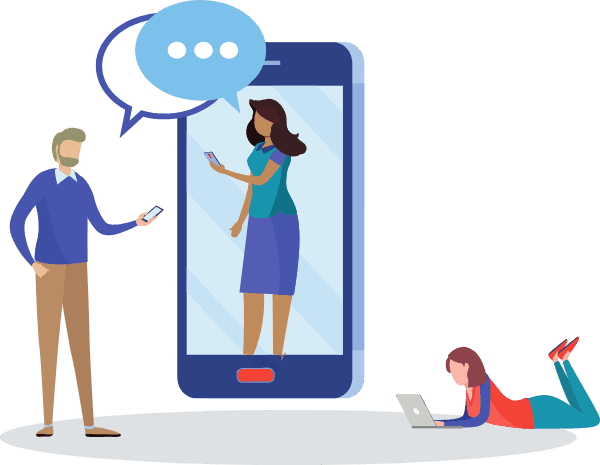
Writing the conversation a user has with the chatbot is only one part of what a conversation designer does. Before we even start writing, the conversation designer has to think through strategy, planning, outlining, and mapping flows.
When planning a chatbot, the conversation designer must create and design all of the dialog paths or flows the user could take to reach the end goal. Those paths can include business goals like sales conversion, issue resolution, subscribing, or something else.
They must also take into consideration—and predict—instances where a user may get confused, say something unexpected, or want to act on an experience that may not be one of the paths designed for the chatbot.
For example, if you have a customer acquisition chatbot designed to give a user a quote for a service, but that user wants to get to customer support instead, you would need a plan for this.
We’ll break the responsibilities of a conversation designer into four phases:
- Strategy
- Design
- Prototyping
- Testing and training
The strategy phase
In the strategy phase, the conversation designer seeks to understand the goals, expectations, and desired outcomes for the bot. Then, the designer has to understand how to meet those goals. And lastly, the designer must decide how the chatbot will lead the user down planned dialog paths to arrive at that goal.
The strategy phase includes the following responsibilities:
- Interviewing the business stakeholders to determine the chatbot goal and key intents
- Interviewing the department stakeholders who understand the steps needed to reach the goal (they could be on the sales or customer support team)
- Creating an outline/flow map of the conversation experience
The writing & design phase
In the writing and design phase, the hard work happens. This is where you’ll build out your specific dialog options and paths for the bot.
The design phase includes the following responsibilities:
- Creating a template for the the key flows based on your flow map
- Creating and documenting the personality of the chatbot
- Writing the dialog of the chatbot
- Writing a few user responses (pre-planned answers available to users)
- Scoping and writing a few intents (answers available to users in the background)
The prototyping phase
In the prototyping phase, we will see the chatbot experience shape up into something that feels more real. You’ll create a mockup of your flows to see and share the user experience with testers.
The prototyping phase includes these responsibilities:
- Choosing a tool or platform for prototyping (for us, it’s Voiceflow)
- Building the hello, fail state or catchall, and goodbye flows (more info soon!)
- Building additional task flows in the prototyping tool
- Ensuring each step includes user responses or intents for them to choose from
The testing & training phase
The testing and training phase, like most user testing, is critical for ensuring that the options we’ve designed actually work for users. We’ll look for opportunities to optimize and streamline our bot before releasing it, and address any loose ends in our flows where the bot might need extra training.
The testing and training phase includes the following responsibilities:
- Exporting and sharing the chatbot prototype
- Reviewing the prototype and identifying friction points, dead ends, or errors with our intents
- Iterating on the chatbot script and writing any additional flows or messages to improve the experience
- Reviewing the prototype with key stakeholders to test comprehension and success based on the initial goals
As the chatbot industry evolves, we may see a future where chatbot “conversation strategists” emerge, and work with a conversation designer to create the ideal experience for a chatbot user. For now, the conversation designer is responsible for all four of these phases.
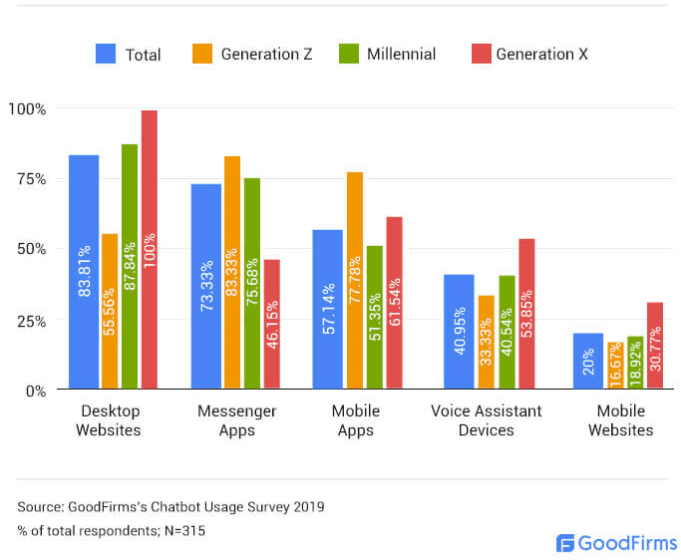
Writing dialog flows
Once a user is inside of a chatbot, they will interact with a variety of flows while they work to achieve their end goal. A flow is a name for a specific section of the conversational dialog, one of the paths. The name comes from the conversation flow, or progression of the conversation. In UX writing and UI design, we’ll often refer to these as “task flows.”
The conversation designer is responsible for writing each of these flows, and also connecting them together so a user is able to seamlessly navigate through the entire conversation on many paths.
To imagine it visually, if you had a flow chart that mapped out the conversation, a flow would be one line on the chart. We call this chart a flow map, which is the outline or dialog tree of the entire chatbot experience. Conversation designers often create these flow maps using tools like Draw.io, Miro or Figma, and use them as a reference guide when creating their script and their prototype. This is like the outline of your chatbot.
Here’s an example of a flow map from draw.io.

There are several key flows that make up a chatbot:
- Hello flow
Greet the user and get them started. - Main flow
Take the user through the intended task. - Goodbye flow
Resolve the experience and ensure satisfaction. - Catch-all flow (also called Repair Path, Fail State, or Fallback)
What the bot says when it doesn’t understand the user’s intent and wants to redirect them.


